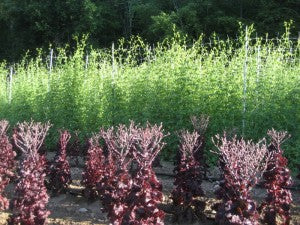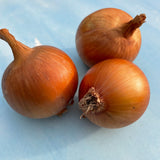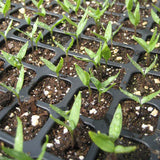
Edible Landscaping: Attractive garden layout tips for edible gardens
 Most gardens today are solely ornamental and many of the ones that are edible are tucked into hidden corners of back yards, valued solely for their contribution to the pantry. But, before this questionable trend of compartmentalizing and eliminating, kitchen gardens, cottage gardens, and landscapes around homes were filled plants that were as beautiful as they were useful. Fortunately, edible landscaping is making a comeback, with more home gardeners choosing to plant attractive edibles that are easy on the eye as well as the dinner plate. A productive, functional and beautiful landscape can be grown on any scale and is especially useful when gardening in a limited space. Here are a few basic ideas to get started:
Most gardens today are solely ornamental and many of the ones that are edible are tucked into hidden corners of back yards, valued solely for their contribution to the pantry. But, before this questionable trend of compartmentalizing and eliminating, kitchen gardens, cottage gardens, and landscapes around homes were filled plants that were as beautiful as they were useful. Fortunately, edible landscaping is making a comeback, with more home gardeners choosing to plant attractive edibles that are easy on the eye as well as the dinner plate. A productive, functional and beautiful landscape can be grown on any scale and is especially useful when gardening in a limited space. Here are a few basic ideas to get started:
 Height and Depth: Pairing together edibles of varying heights in one bed or area creates an interesting look similar to wilder-inclined flower beds. Most vegetables prefer a full day of sun, but not all. Many greens and cool-weather loving edibles enjoy the relief of some shade in the hottest parts of the year, so consider interplanting them with taller sun-loving vegetables and edible flowers or herbs. For example, the handsome Spotted Trout Lettuce can be planted under Ping Pong Tomatoes for contrasting colors, depth, height, and a one-stop salad harvest. African Crackerjack Marigolds (a very tall variety) can serve as a backdrop for a row of alternating Red Russian Kale and Purple Vienna Kolhrabi, with Arugula or Spinach interplanted between the brassicas – for a rich landscape of orange, red, purple, and deep green.
Height and Depth: Pairing together edibles of varying heights in one bed or area creates an interesting look similar to wilder-inclined flower beds. Most vegetables prefer a full day of sun, but not all. Many greens and cool-weather loving edibles enjoy the relief of some shade in the hottest parts of the year, so consider interplanting them with taller sun-loving vegetables and edible flowers or herbs. For example, the handsome Spotted Trout Lettuce can be planted under Ping Pong Tomatoes for contrasting colors, depth, height, and a one-stop salad harvest. African Crackerjack Marigolds (a very tall variety) can serve as a backdrop for a row of alternating Red Russian Kale and Purple Vienna Kolhrabi, with Arugula or Spinach interplanted between the brassicas – for a rich landscape of orange, red, purple, and deep green.
In extra cramped quarters, the same effects can be achieved within one pot. For example, Nasturtiums (edible flowers with a peppery kick) can serve as a “groundcover,” draping over the side of a tall container, with one Rainbow Chard and Tom Thumb Pea plant growing up from the center of the pot.
Succession sowing is also a useful tool both for food production and for growing an edible landscape. For example, radishes – a quickly maturing crop -- can be interplanted with Red Express Cabbage – a pretty, petite cabbage that matures quickly, for a cabbage. Sunflowers can be added to complete the trio, which will eventually grow tall enough to shade out the entire area, but not before the radishes and cabbages are ready to be harvested.

Colorful Contrast: Simply planting your go-to vegetables in a new formation creates a beautiful, new landscape. Planting Rainbow Lacinato Kale and Silverado Chard in one block creates a white, green and purple color contrast. Grouping a variety of colorful flowers and vegetables in a cluster instead of a row will automatically bring aesthetic interest to a corner of your garden.
The easiest way to create colorful contrast is to let some of your edible plantings go to seed! Not only will you end season with your very own seed bank, but ordinary plants will assume beautiful, new forms: lettuces, for example, will grow tall and bloom like clusters of tiny dandelions; leeks will shoot out one long stalk with a giant, lavender-hued, globe-shaped blossom.
Choose unusual varieties of usual vegetables in the interest of color, nutrition, and flavor. Merlot Lettuce is merlot colored, Lemon Cucumbers are lemon colored, and Rainbow Chard, yes – also true to its name – comes with stalks in varying colors.
 Substitute: Another helpful way to think about edible landscapes is to substitute edible varieties for each role you want a plant to serve in the garden. If it’s shade you are after, plant a fruit tree. A vine to climb up the back fence? How about peas, followed by pole beans: they have beautiful flowers and foliage and also produce delicious pods. Looking for a petite tuft of grass to edge your pathway? How about chives instead – an hardy, perennial with great flavor and attractive magenta blooms. Thyme works great not only as an indispensible seasoning, but as a groundcover too, especially in between a stone pathway. Even flower gardens can be a feast for the eyes as well as taste buds: take a look at our list of 19 Favorite Edible Flowers.
Substitute: Another helpful way to think about edible landscapes is to substitute edible varieties for each role you want a plant to serve in the garden. If it’s shade you are after, plant a fruit tree. A vine to climb up the back fence? How about peas, followed by pole beans: they have beautiful flowers and foliage and also produce delicious pods. Looking for a petite tuft of grass to edge your pathway? How about chives instead – an hardy, perennial with great flavor and attractive magenta blooms. Thyme works great not only as an indispensible seasoning, but as a groundcover too, especially in between a stone pathway. Even flower gardens can be a feast for the eyes as well as taste buds: take a look at our list of 19 Favorite Edible Flowers.







